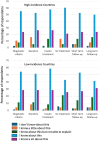Knowledge, Attitudes, and Practices in Neonatal Diabetes Mellitus Management: the JEnious-NeOnatal-DIabetes (JENODI) Survey
- PMID: 40106224
- PMCID: PMC12006576
- DOI: 10.1007/s13300-025-01714-x
Knowledge, Attitudes, and Practices in Neonatal Diabetes Mellitus Management: the JEnious-NeOnatal-DIabetes (JENODI) Survey
Abstract
Introduction: We aimed to explore the knowledge, attitude, and management of neonatal diabetes mellitus (NDM) among members of the International Society for Pediatric and Adolescent Diabetes (ISPAD).
Methods: Members of the society were invited to complete an online questionnaire posted on the ISPAD website.
Results: We received 108 responses from 45 different countries. Of these, 103 were involved in NDM management. 87.9% of participants would start insulin at diagnosis, and 11% would prefer sulfonylurea (SU); 54.6% would start with an insulin pump, and 80.6% would use continuous glucose monitoring. Genetic testing was suggested by 97.2% (50.9% when diagnosis occurs up to 6 months, 15.7% up to 9 months, and 30.6% up to 12 months of age), while 79.6% routinely request it in clinical practice. Of the participants, 96.3% consider genetic testing necessary to identify children who can be treated with SU, and 26.9% would try SU before testing/obtaining results. Only 37% received specific training on NDM, while 44.5% felt less confident in managing patients with NDM. Incidence in the country of practice, participant's age, years of experience in the field, number of patients registered in the clinic, and number of patients with NDM followed up were associated with differences in answers.
Conclusions: This survey offers the possibility of informing health providers about the awareness of different aspects of NDM management. Our results provide the opportunity to compare various aspects of diagnosis and treatment of NDM in different geographic areas. Continuous education is needed to boost physicians' confidence in managing patients with this rare form of diabetes.
Keywords: Education; Genetics; Insulin; Neonatal diabetes mellitus; Sulfonylurea.
© 2025. The Author(s).
Conflict of interest statement
Declarations. Conflict of Interest: All the authors (Maurizio Delvecchio, Claudia Piona, Agata Chobot, Laura Cudizio, Asma Deeb, Nancy Elbarbary, Tiago Jeronimo Dos Santos, Abdelhadi Habeb) do not declare any competing interests. Maurizio Delvecchio is an Editorial Board member of Diabetes Therapy. Maurizio Delvecchio was not involved in the selection of peer reviewers for the manuscript nor any of the subsequent editorial decisions. Ethical Approval: The survey was reviewed and approved by the Arab Society for Pediatric Endocrinology and Diabetes (ASPED) research committee. As an anonymous survey that did not collect any personal information or views of the survey participants, the study is exempt from ethical approval, similarly to other survey already published. Participants were informed that their response would be used as part of a publication. No copyright was required for the questionnaire.
Figures
References
-
- Habeb AM, Al-Magamsi MS, Eid IM, Ali MI, Hattersley AT, Hussain K, et al. Incidence, genetics, and clinical phenotype of permanent neonatal diabetes mellitus in northwest Saudi Arabia. Pediatr Diabetes. 2012;13(6):499–505. 10.1111/j.1399-5448.2011.00828.x. - PubMed
LinkOut - more resources
Full Text Sources


